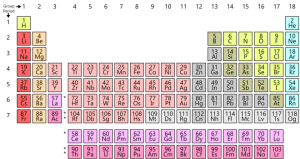Periodic Table

The Periodic Table is a tabular arrangement of the chemical elements, ordered by their atomic number, electron configuration, and recurring chemical properties, whose structure shows periodic trends. Generally, within one row (period) the elements are metals to the left, and non-metals to the right, with the elements having similar chemical behaviours placed in the same column. Table rows are commonly called periods and columns are called groups. Six groups have accepted names as well as assigned numbers: for example, group 17 elements are the halogens; and group 18 are the noble gases. Also displayed are four simple rectangular areas or blocks associated with the filling of different atomic orbitals. All the elements from atomic numbers 1 (hydrogen) through 118 (oganesson) have been either discovered or synthesized, completing the first seven rows of the periodic table.[1][2] The first 98 elements exist in nature, although some are found only in trace amounts and others were synthesized in laboratories before being found in nature.[n 1] Atomic numbers for elements 99 to 118 have only been synthesized in laboratories or nuclear reactors.[ [1]
References

